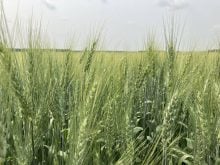The prevalence of crop disease can be hard to predict, but Saskatchewan farmers are advised to watch for the usual suspects and a potential formidable newcomer this year.
Clubroot
The fungal disease hasn’t made an official appearance in Saskatchewan, but clubroot is a significant threat to canola growers.
At last week’s annual convention of the Saskatchewan Association of Rural Municipalities, one delegate said farmers are taking chances by growing canola four out of six years. Clubroot has shown up in Alberta canola fields and is expected to make its way east.
Read Also

Why feds imposed EV tariffs
Moe and Kinew have a fight on their hands when it comes to eliminating the EV tariff. Canada has to worry about pissing off the U.S. and Mexico and hundreds of thousands of auto workers.
“A lot of us think it’s just waiting for an explosion to happen here,” said Leonard Junop of Vanscoy.
A soil sample collected in west-central Saskatchewan in the fall of 2008 tested positive for the soil-borne disease that is spread by spores and affects the roots of cruciferous crops and weeds.
The results from 60 samples collected last fall are not yet known, said Brent Flaten, the province’s integrated pest management specialist.
However, none of the plants in the surveyed fields displayed disease symptoms, which include premature dying back of the plants and the presence of galls on the roots.
“The longer we can keep it out, it just gives us a little more breathing room,” Flaten said, noting researchers are developing resistant varieties.
Blackleg
Blackleg in canola will be a problem for some growers this year.
“In the southeast, there seems to be a bit of resurgence,” Flaten told growers at a recent soil conservation association conference.
The fungal disease continues to adapt to survive.
“There’s new races being discovered all the time,” he said.
Agriculture Canada research conducted in Melfort has identified 18 races of blackleg; nine of them are common.
Flaten said varieties rated for blackleg resistance may not have resistance to all of the races, and he reminded producers that even varieties considered resistant can have infection rates as high as 30 percent.
Ascochyta
Ascochyta resistance in chickpeas has become a significant problem and underscores the need for fungicide management.
Research in randomly selected chickpea fields found that 100 percent of ascochyta samples were susceptible to the strobilurin Headline in 2004-2005; by 2007, 97 percent of samples were resistant.
“That’s how quickly ascochyta resistance to the fungicide occurred,” Flaten said.
Others
The right environmental conditions could lead to an outbreak of any crop disease, Flaten said.
“Root rots have been quite pronounced the last two years because of the cold springs.”
Fusarium inoculant is widespread across the province, he said, and the disease will be a problem if it is hot and humid at the right time.
“Ergot was a hot topic a couple of years ago,” Flaten said. “This year, who knows?”
The problem in 2008 was that the wheat crop flowered much longer than usual because of increased tillering.
Flaten said leaf diseases are always hard to predict. The weather is the key factor.















